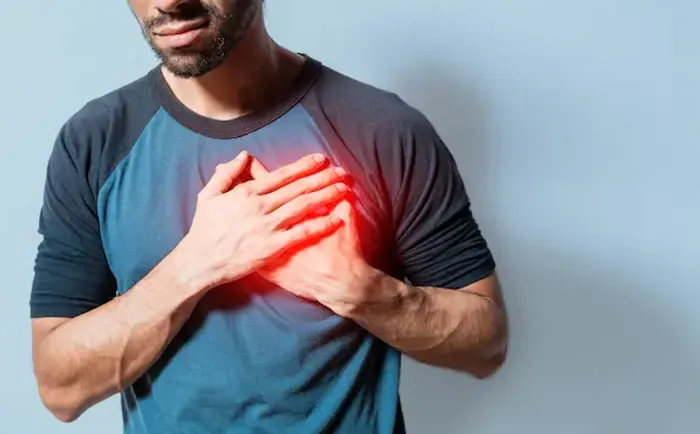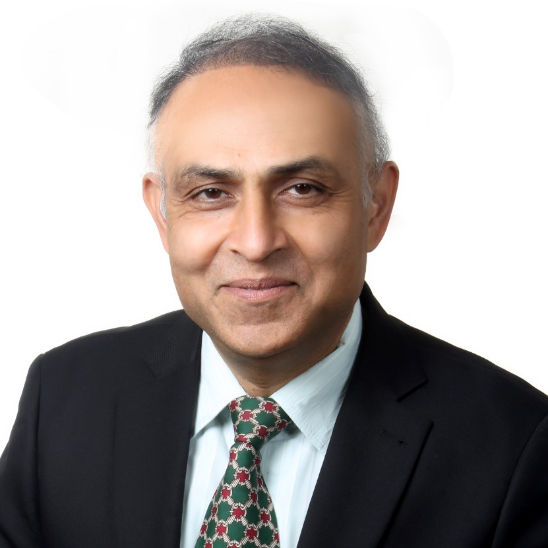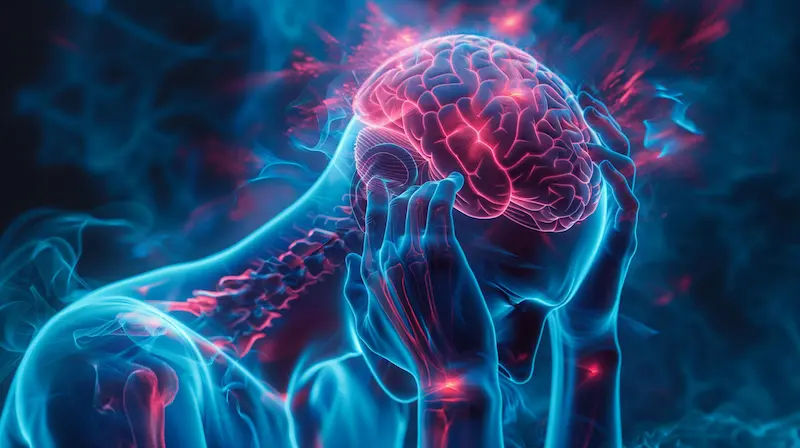What Leads To Signs Of Tachycardia And Types
Learn what tachycardia is, its causes, symptoms, and treatment options. Understand different types like SVT, AF, and VT, and when to seek urgent care.

Written by Dr. Mohammed Kamran
Reviewed by Dr. Shaik Abdul Kalam MD (Physician)
Last updated on 29th Oct, 2025

Introduction
A racing heartbeat can be scary—especially when it seems to come out of nowhere. Tachycardia means your heart is beating faster than normal. Sometimes it’s a healthy response to exercise or stress. Other times, tachycardia signals a heart rhythm problem or a medical issue that needs attention. Understanding what leads to signs of tachycardia and its types helps you decide what to do next, from simple self-care to getting urgent help.
In this guide, you’ll learn what tachycardia is, the common symptoms to watch for, and what can trigger it—from fever and dehydration to thyroid problems and heart disease. We’ll break down the major types, including sinus tachycardia, supraventricular tachycardia (SVT), atrial fibrillation, and ventricular tachycardia, and explain how doctors diagnose and treat them. You’ll also get practical first-aid tips, lifestyle strategies, and clear advice on when to seek immediate care. If symptoms persist beyond two weeks, consult a doctor online with Apollo 24|7 for further evaluation. Let’s make sense of tachycardia so you can protect your heart with confidence.
What Is Tachycardia? Normal vs Fast Heart Rate
Tachycardia is generally defined as a heart rate over 100 beats per minute in adults at rest. Your heart’s job is to pump blood efficiently; rate and rhythm are controlled by an electrical system that starts in the sinoatrial (SA) node and travels through the atrioventricular (AV) node into the ventricles. When that system speeds up appropriately—say, during exercise, stress, or fever—you may feel your heart pounding, but it’s a normal physiological response called sinus tachycardia.
How the Heart’s Electrical System Keeps Rhythm
- The SA node (your natural pacemaker) sets the pace.
- Signals pass through the AV node to the ventricles, producing a coordinated squeeze.
- In tachycardia, either the SA node fires faster, an abnormal circuit forms (reentry), or extra beats originate in the atria or ventricles.
When a Fast Heartbeat Is Normal (and When It’s Not)
- Normal: exercise, excitement, heat, pregnancy, or mild dehydration can raise heart rate temporarily.
- Not normal: sudden, unexplained episodes at rest, irregular “fluttering,” chest pain, fainting, or severe shortness of breath suggest a rhythm problem that deserves prompt evaluation. If you experience those red flags, seek urgent care.
Signs and Symptoms of Tachycardia
Tachycardia symptoms vary. Some people notice strong, rapid palpitations; others feel only light-headed or unusually tired. Typical symptoms include:
- Palpitations (a racing, pounding, or skipping feeling)
- Shortness of breath, especially with activity
- Chest discomfort or pressure
- Dizziness or near-fainting
- Anxiety or an urge to cough
- Reduced exercise tolerance
Red-Flag Symptoms That Need Urgent Care
- Fainting (syncope) or severe dizziness
- Chest pain, pressure, or a sense of “impending doom”
- Severe shortness of breath or confusion
- A known heart condition with a new, very fast heart rate
If any of these occur, call emergency services immediately. Ventricular tachycardia and ventricular fibrillation can be life-threatening without rapid treatment.
Keep a symptom diary noting time, duration, triggers (caffeine, stress), and associated symptoms. If you use a wearable
ECG or heart rate tracker, save recording snippets to show your clinician. However, remember that wearables can misread, and a clinic ECG is still the gold standard.
What Leads to Tachycardia? Common Causes and Triggers
Tachycardia has many causes—some cardiac, many not. Understanding triggers helps you prevent episodes and guides testing.
Heart-Related Causes and Risk Factors
- Coronary artery disease or past heart attack (scarring can cause reentry circuits leading to ventricular tachycardia).
- Cardiomyopathy, heart failure, or valve disease.
- Congenital accessory pathways (e.g., Wolff-Parkinson-White) leading to AVRT.
- Structural issues identified on echocardiography.
Non-Cardiac Causes
- Fever, infection, dehydration
- Anaemia (low haemoglobin)
- Hyperthyroidism or thyroid hormone over-replacement
- Pulmonary issues (asthma flare, blood clots in lungs)
- Pregnancy (higher blood volume and heart rate)
- Pain, anxiety, panic
Lifestyle, Stimulants, and Medication Triggers
- Caffeine, energy drinks, nicotine, alcohol binges (“holiday heart”)
- Recreational drugs (cocaine, amphetamines)
- Certain cold/flu medicines or decongestants
- Sleep deprivation and obstructive sleep apnoea
- Heat exposure and strenuous unaccustomed exercise
Types of Tachycardia at a Glance
Think of tachycardia types by where they start and how they behave on ECG.
Sinus Tachycardia and Inappropriate Sinus Tachycardia (IST)
- Sinus tachycardia: starts in the SA node; often a normal response.
- IST: persistent, bothersome fast sinus rhythm at rest, not explained by other causes.
Supraventricular Tachycardia (SVT) Umbrella
- AVNRT: reentry circuit near the AV node causes sudden-onset, regular, fast rhythm.
- AVRT: involves an extra pathway (e.g., WPW).
- Focal atrial tachycardia: a small area in the atrium fires rapidly.
- Atrial flutter: a macro-reentry in the atrium producing a sawtooth pattern on ECG.
Atrial Fibrillation (AF)
Irregular, chaotic atrial activity with an “irregularly irregular” pulse; increases stroke risk and often requires anticoagulation.
Ventricular Tachycardia (VT) and Ventricular Fibrillation (VF)
- VT: fast rhythm from the ventricles; can be dangerous, especially in structural heart disease.
- VF: chaotic ventricular activity; causes cardiac arrest without immediate defibrillation.
Consult Top Specialists Here
Supraventricular Tachycardia (SVT): What It Is and How It’s Treated
AVNRT and AVRT are the most common SVTs. They typically begin abruptly and may be provoked by stress, caffeine, or no obvious trigger.
Symptoms and Diagnosis
- Palpitations, chest discomfort, breathlessness, light-headedness, and anxiety.
- ECG during the episode is ideal. Holter monitors or event monitors capture intermittent episodes.
First Aid: Vagal Manoeuvres for SVT
- Modified Valsalva (bearing down while reclined with legs raised) can terminate some SVTs.
- Avoid if you have chest pain, severe shortness of breath, or feel faint—seek urgent care.
Treatment and Ablation
- Beta-blockers or calcium channel blockers may prevent episodes.
- Adenosine can stop AVNRT/AVRT in clinical settings.
- Catheter ablation is often curative, with success rates above 90% in experienced centres.
Atrial Fibrillation: The Most Common Irregular Tachycardia
AF produces an irregular pulse and can increase stroke risk.
Stroke Risk and Anticoagulation
- AF can raise stroke risk several times over baseline.
- Doctors use risk scores to decide on anticoagulation.
Rate vs Rhythm Control
- Rate control: beta-blockers slow the heart.
- Rhythm control: restore normal rhythm via medication, cardioversion, or ablation.
Lifestyle Factors
Alcohol binges, sleep apnoea, obesity, and high blood pressure increase AF risk. Managing these helps reduce recurrences.
Ventricular Tachycardia and Fibrillation: Recognise the Emergencies
Ventricular tachycardia (VT) is a fast rhythm from the lower chambers. Ventricular fibrillation (VF) stops effective
pumping and causes cardiac arrest without immediate defibrillation.
When VT Happens
- Common after heart attacks or in cardiomyopathy.
- Inherited conditions like long QT or Brugada syndrome increase risk.
Emergency Care and Devices
- VT/VF requires immediate defibrillation.
- Implantable cardioverter-defibrillators (ICDs) prevent sudden cardiac death in high-risk patients.
Warning Signs
- Fainting or near-fainting during palpitations
- Palpitations with chest pain or shortness of breath
- A known weak heart with sudden fast pounding
Sinus Tachycardia, IST, and POTS: Similar Names, Different Problems
Not every rapid heartbeat is abnormal.
IST (Inappropriate Sinus Tachycardia)
Persistent, elevated resting rate with distressing palpitations not explained by other causes.
POTS (Postural Orthostatic Tachycardia Syndrome)
Defined by a heart rate rise of over 30 bpm on standing.
How to Tell Them Apart
- IST: high at rest.
- POTS: heart rate spikes mainly on standing.
Practical Management
Hydration, increased salt, gradual exercise, compression garments, and medical review of medications can help.
How Tachycardia Is Diagnosed
Diagnosis starts with a careful history and rhythm capture.
ECG and Monitors
- 12-lead ECG
- Holter or event monitors
- Implantable loop recorders for rare episodes
Imaging and Lab Tests
- Echocardiogram
- Thyroid, blood count, electrolytes
Electrophysiology (EP) Study
Maps electrical pathways and may include ablation.
Wearables
Helpful for tracking but not definitive.
First Aid and Everyday Management
- Vagal manoeuvres: Modified Valsalva (blowing into syringe for 15 seconds).
- Emergency signs: chest pain, fainting, severe shortness of breath.
- Lifestyle: hydration, regular sleep, limit caffeine and alcohol.
Medical Treatments: Medicines, Ablation, and Devices
- Medicines: beta-blockers, calcium channel blockers, and antiarrhythmics.
- Catheter ablation: highly effective for AVNRT/AVRT.
- ICDs: prevent sudden death in high-risk cases.
Special Situations: Pregnancy, Children, and Athletes
- Pregnancy: heart rate naturally rises. Most SVTs are benign.
- Children: SVT is common; prompt paediatric review is vital.
- Athletes: differentiate normal training heart rates from arrhythmia.
Prevention and Risk Reduction
- Manage blood pressure, diabetes, and thyroid issues.
- Avoid stimulant medications.
- Track triggers and monitor trends.
When and Where to Seek Care
- Doctors may ask about timing, triggers, and family history.
- ECG, echocardiogram, and blood tests help diagnose.
- Apollo 24|7 offers home lab collection and online consultation.
Conclusion
Tachycardia is common—and in many cases, manageable—once you understand what causes it and how to respond. A fast heartbeat can be a normal reaction to exercise or stress, but persistent or sudden episodes at rest deserve attention. Start by identifying triggers you can control—hydration, caffeine limits, sleep quality—and learn simple first-aid like vagal manoeuvres for suspected SVT. For irregular rhythms like atrial fibrillation, stroke prevention and symptom control are key.
With the right evaluation—ECG, ambulatory monitors, echocardiography, and targeted labs—most people get a clear diagnosis and a tailored plan. Options range from lifestyle changes and medicines to highly effective catheter ablation or, for high-risk conditions, implantable defibrillators. If symptoms persist beyond two weeks or disrupt your daily life, consult a doctor online with Apollo 24|7 to discuss testing and treatment.
Consult Top Specialists Here
Consult Top Specialists Here

Dr. Tripti Deb
Cardiologist
40 Years • MBBS, MD, DM, FACC, FESC
Hyderabad
Apollo Hospitals Jubilee Hills, Hyderabad

Prof. Dr. Vivek Gupta
Cardiologist
25 Years • MD, DM, FESC, FEAPCI, FAPSIC,FCSI, FICC, FIC France, FIEIC, FSCAI
Delhi
Apollo Hospitals Indraprastha, Delhi
(25+ Patients)

Dr. Chandra Prakash Thakur
Cardiologist
5 Years • MBBS, MD ( Medicine), DM ( Cardiology)
Guwahati
Apollo Hospitals G S Road, Guwahati
Dr. Mahendranath Subramani Prasad
Cardiologist
16 Years • MBBS,MS ,DNB, M.Ch. Cardiovascular and Thoracic Surgery(Cardiology)
Bengaluru
Apollo Clinic, Sarjapur Road, Bengaluru

Dr. Monik Mehta
Cardiologist
38 Years • MBBS, MD, DM (Cardiology), FACC (Fellow of American College of Cardiology), Fellowship (Cardiac Electrophysiology)
Gurugram
APOLLO SUGAR CLINICS GURUGRAM, Gurugram
Consult Top Specialists Here

Dr. Tripti Deb
Cardiologist
40 Years • MBBS, MD, DM, FACC, FESC
Hyderabad
Apollo Hospitals Jubilee Hills, Hyderabad

Prof. Dr. Vivek Gupta
Cardiologist
25 Years • MD, DM, FESC, FEAPCI, FAPSIC,FCSI, FICC, FIC France, FIEIC, FSCAI
Delhi
Apollo Hospitals Indraprastha, Delhi
(25+ Patients)

Dr. Chandra Prakash Thakur
Cardiologist
5 Years • MBBS, MD ( Medicine), DM ( Cardiology)
Guwahati
Apollo Hospitals G S Road, Guwahati
Dr. Mahendranath Subramani Prasad
Cardiologist
16 Years • MBBS,MS ,DNB, M.Ch. Cardiovascular and Thoracic Surgery(Cardiology)
Bengaluru
Apollo Clinic, Sarjapur Road, Bengaluru

Dr. Monik Mehta
Cardiologist
38 Years • MBBS, MD, DM (Cardiology), FACC (Fellow of American College of Cardiology), Fellowship (Cardiac Electrophysiology)
Gurugram
APOLLO SUGAR CLINICS GURUGRAM, Gurugram
More articles from General Medical Consultation
Frequently Asked Questions
1) Is tachycardia always dangerous?
No. Sinus tachycardia is often normal during exercise, fever, or stress. But unexplained, frequent, or symptomatic episodes—especially with chest pain, fainting, or severe breathlessness—need medical evaluation.
2) How can I tell if my fast heartbeat is SVT or anxiety?
SVT often starts and stops suddenly and may respond to vagal manoeuvres. Anxiety-related tachycardia usually builds gradually and eases with relaxation.
3) Can caffeine cause tachycardia?
Yes. Caffeine and energy drinks can trigger palpitations or SVT in susceptible people.
4) What is the success rate of catheter ablation for SVT?
For common SVTs, ablation success rates are often above 90% with low complication rates.
5) Do I need blood thinners if I have atrial fibrillation?
It depends on your stroke risk, which your doctor will assess based on age, blood pressure, and other conditions.




